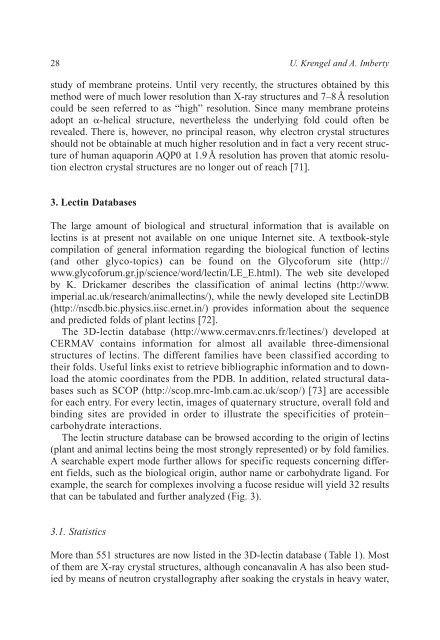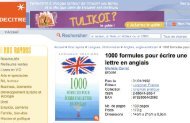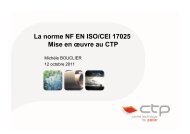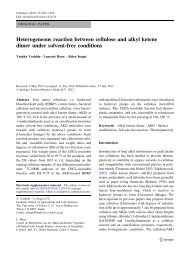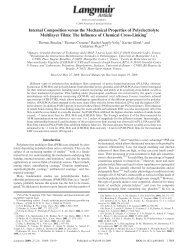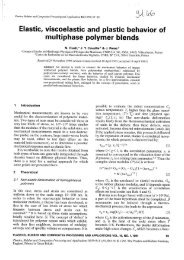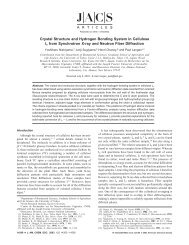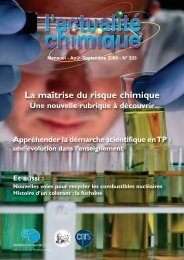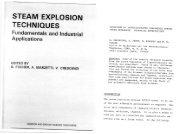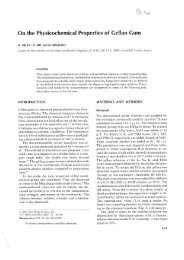Crystallography and Lectin Structure Database - CNRS
Crystallography and Lectin Structure Database - CNRS
Crystallography and Lectin Structure Database - CNRS
You also want an ePaper? Increase the reach of your titles
YUMPU automatically turns print PDFs into web optimized ePapers that Google loves.
28 U. Krengel <strong>and</strong> A. Imberty<br />
study of membrane proteins. Until very recently, the structures obtained by this<br />
method were of much lower resolution than X-ray structures <strong>and</strong> 7–8 Å resolution<br />
could be seen referred to as “high” resolution. Since many membrane proteins<br />
adopt an -helical structure, nevertheless the underlying fold could often be<br />
revealed. There is, however, no principal reason, why electron crystal structures<br />
should not be obtainable at much higher resolution <strong>and</strong> in fact a very recent structure<br />
of human aquaporin AQP0 at 1.9 Å resolution has proven that atomic resolution<br />
electron crystal structures are no longer out of reach [71].<br />
3. <strong>Lectin</strong> <strong>Database</strong>s<br />
The large amount of biological <strong>and</strong> structural information that is available on<br />
lectins is at present not available on one unique Internet site. A textbook-style<br />
compilation of general information regarding the biological function of lectins<br />
(<strong>and</strong> other glyco-topics) can be found on the Glycoforum site (http://<br />
www.glycoforum.gr.jp/science/word/lectin/LE_E.html). The web site developed<br />
by K. Drickamer describes the classification of animal lectins (http://www.<br />
imperial.ac.uk/research/animallectins/), while the newly developed site <strong>Lectin</strong>DB<br />
(http://nscdb.bic.physics.iisc.ernet.in/) provides information about the sequence<br />
<strong>and</strong> predicted folds of plant lectins [72].<br />
The 3D-lectin database (http://www.cermav.cnrs.fr/lectines/) developed at<br />
CERMAV contains information for almost all available three-dimensional<br />
structures of lectins. The different families have been classified according to<br />
their folds. Useful links exist to retrieve bibliographic information <strong>and</strong> to download<br />
the atomic coordinates from the PDB. In addition, related structural databases<br />
such as SCOP (http://scop.mrc-lmb.cam.ac.uk/scop/) [73] are accessible<br />
for each entry. For every lectin, images of quaternary structure, overall fold <strong>and</strong><br />
binding sites are provided in order to illustrate the specificities of protein–<br />
carbohydrate interactions.<br />
The lectin structure database can be browsed according to the origin of lectins<br />
(plant <strong>and</strong> animal lectins being the most strongly represented) or by fold families.<br />
A searchable expert mode further allows for specific requests concerning different<br />
fields, such as the biological origin, author name or carbohydrate lig<strong>and</strong>. For<br />
example, the search for complexes involving a fucose residue will yield 32 results<br />
that can be tabulated <strong>and</strong> further analyzed (Fig. 3).<br />
3.1. Statistics<br />
More than 551 structures are now listed in the 3D-lectin database (Table 1). Most<br />
of them are X-ray crystal structures, although concanavalin A has also been studied<br />
by means of neutron crystallography after soaking the crystals in heavy water,


